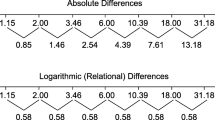Abstract
Two studies are discussed in which children's use of the anchoring and adjustment heuristic was considered. Study one is a modification of the classic multiplication task devised by Kahneman and Tversky (1974). Results indicate that children in grades 4, 6, 8 and adults are affected by the order of numbers provided in an addition task. In addition, younger children display the tendency to over adjust, yielding higher estimates. In the second study, third and fifth grade participants and adults were provided anchors and estimated the number of jellybeans in a glass container. A main effect for condition is indicated, with lower anchors leading to lower estimates. Results of both studies are consistent with the an anchoring and adjustment explanation.
Similar content being viewed by others
References
Agnoli, F. (1991). Development of judgmental heuristics and logical reasoning: Training counteracts the representativeness heuristic. Cognitive Development, 6, 95–217.
Davidson, D. (1995). The representativeness heuristic and the conjunction fallacy effect in children's decision making. Merrill-Palmer Quarterly, 41 (3), 328–346.
Davies, M. and White, P.A. (1994). Use of availability heuristic by children. British Journal of Developmental Psychology, 12, 503–505.
Jacobs, J.E. and Potenza, M. (1991). The use of judgment heuristics to make social and object decisions: A developmental perspective. Child Development, 62, 166–178.
Kahneman, D., Slovic, P., and Tversky, A. (1982). Judgment under uncertainty: Heuristics and biases. Cambridge University Press, Cambridge.
Ross, L. (1981). The intuitive scientist formulation. In Flavell, J. and Ross, L. (Eds.) Social Cognitive Development: Frontiers and Possible Futures. 1–42, New York, NY, Cambridge University Press.
Scholz, R.W. (1983) Decision Making Under Uncertainty. Amsterdam: Elsevier Science Publishers.
Smith, H.D. (1995). Judgmental heuristic use among children: A preliminary investigation. Paper presented as part of a symposium entitled “Children's use of heuristics and intuitive reasoning: What develops?” (Organized by Janis Jacobs) at the biennial meeting of the Society for Research in Child Development, March, Indianapolis, IN.
Tabachnik, B. and Fidel, L. (1989), Using Multivariate Statistics. New York: Harper & Row.
Tversky, A. and Kahneman, D. (1974). Judgment under uncertainty: Heuristics and Biases. Science, 185, 1124–1131.
Author information
Authors and Affiliations
Corresponding author
Rights and permissions
About this article
Cite this article
Smith, H.D. Use of the anchoring and adjustment heuristic by children. Curr Psychol 18, 294–300 (1999). https://doi.org/10.1007/s12144-999-1004-4
Issue Date:
DOI: https://doi.org/10.1007/s12144-999-1004-4




